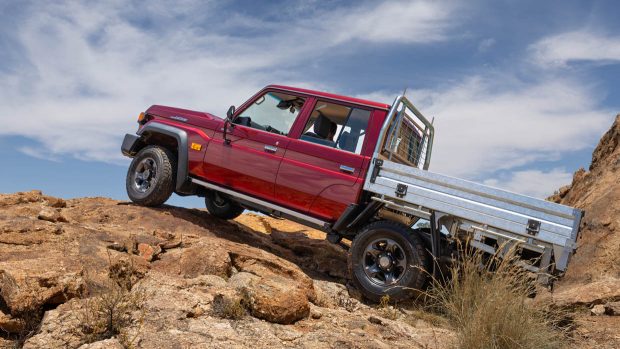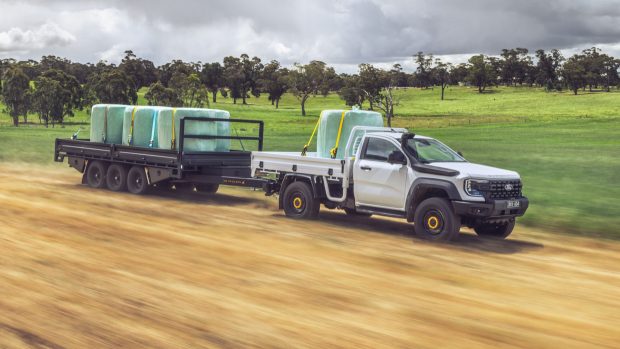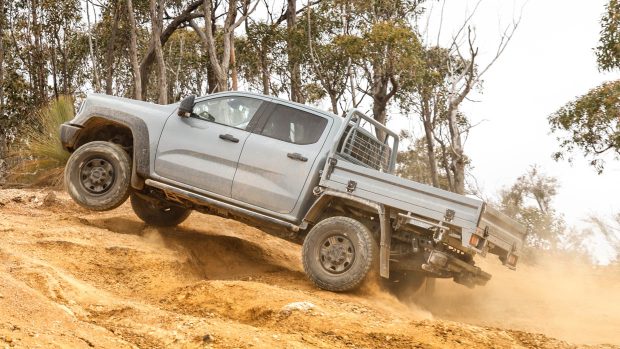-
Car Reviews
- All reviews
- Midsize SUVs
- Small cars
- Utes
- Small SUVs
- Large SUVs
- Large cars
- Sports SUVs
- Sports cars
- Vans
Latest reviews
- Car News
-
Car Comparisons
Latest comparisons
- Chasing Deals
The old-as-time LC79 Series is the default choice for extreme Australian use. Can Ford convince Aussies to ditch the old faithful?
As Ford’s Ranger Super Duty mid-size truck lands in Aussie showrooms, there’s a whiff of change in the air.
It’s the smell of a Blue Oval diesel-drinking 3.0L V6 wafting over our scorched outback, through mines, rural worksites and farms, where for the longest time it’s been Toyota country. Specifically, Toyota LandCruiser 70 Series country, led by the near-unbreakable 79 Series ute.
Ford’s Australia-developed, Thailand-built Ranger Super Duty aims to be disruptor-in-chief, offering a viable alternative to the LC79 Series Cab Chassis pickup, which has for decades been default choice for those whose work and even life depend on an always-reliable vehicle.
Said 79 Series has been in service – with very little change to the tried-and-tested formula – since 1984. Aussies still sang God Save The Queen at sports events back then.
The V6 Ranger Super Duty with 4500kg towing, 4500kg GVM and 8000Kg GCM lands at an opportune time.
Toyota’s ditched the much-loved 4.5L V8 turbo-diesel (mainly due to emissions woes) and buyers can only now opt for the 150kW/500Nm 2.8L four-cylinder turbo-diesel that sees service in the Hilux and Prado.
And many working the land aren’t happy. The 2.8L may near-match the V8’s power and offers 70Nm higher torque, but you remove an Aussie’s bent-eight at your peril.
Ford’s 3.0L V6 has those two extra cylinders and greater displacement, which could push disgruntled buyers in the Blue Oval’s direction.
And it’s a lucrative direction. Toyota shifted over 11,000 79 Series Cab Chassis pickups in 2024, and at around $80,000 a pop, that’s serious business Ford wants to carve into.
The Super Duty has the Toyota licked on numbers, certainly.
A LC79 Series offers only 3500kg towing (-1000kg), 3510kg GVM (-990kg) and 7010kg GCM (-990kg), while its best payload is 1380kg in the Single Cab Chassis.
The Ranger Super Duty goes bigger: 1982kg payload in the 4×4 Single Cab Chassis body style; 1885kg in Super Cab Chassis and 1825kg in Double Cab Chassis.
Price, too, is comparable. Toyota’s 70 Series Single Cab Chassis starts from $76,800 and Double Cab Chassis from $77,300. Ford’s three bodies are $82,990, $86,490 and $89,990 respectively.
But the million-dollar question is reliability, in particular Ford’s V6 “Lion” turbo-diesel. Owner forums report numerous dramas and failures, while Ford Australia recalled over 13,000 Ranger and Everest V6s this April to remedy a manufacturing defect in the left-hand engine camshaft sprocket.
Buyers who depend on a vehicle with the Super Duty’s abilities will need plenty of convincing to make the Ford shift.
Andrew Birkic, President and CEO of Ford Australia, spoke to Australian media at the Super Duty’s launch, championing the Ranger’s success due to customer confidence, while acknowledging reliability challenges.
“I think we’ve learnt some lessons from some of those issues, and we’ve addressed them in the field,” he said. “We’ll always do the right thing by that and look after our customers.
“We’ve been selling a lot of Rangers, it’s Australia’s top selling car the last two years and we’re going for three in a row.
“There’s a lot of Rangers out there, so we’ve got a lot of data. The genesis of this (Super Duty) truck is work, and so what we know is that durability and quality is a significant story, and has to be.
“That’s why we’ve had a very rigorous testing regime, and we’ll continue to do that, as it’s been a cornerstone of the project.”
The Super Duty’s V6 offers 154kW; down from the 184kW in a normal Ranger and Everest V6, due to changes made to make the engine EU6-compliant. It’s also necessitated AdBlue to reduce nitrous oxide emissions.
Ford Australia didn’t go into detail on what else had been changed with the V6, but stated it had “unique transmission and engine calibrations to ensure optimum usage of the torque of the engine,” better suited to extreme workloads.
Said transmission is Ford’s long-serving 10-speed auto, while the 600Nm engine torque remains unchanged next to a normal Ranger.
But the reduced power number will likely concern many Super Duty buyers, especially those planning on properly exploiting its lugging and towing abilities.
The powertrain aside, there’s no question the development work and field testing has been exhaustive.
Engineering Supervisor for Ranger Super Duty, Drew O’Shannassy, explained their testing included pushing the hardcore Ranger to breaking point.
“We want to deliver the biggest GVM, payload, towing, off-road capabilities and robustness,” he said. “One of the challenges we got when we went back to the senior leadership was ‘bring us more broken parts, push this thing further, go find the limits on every part so we can fix them.’”
Reassuring stuff. And O’Shannassy said for Super Duty they conducted testing they’d never done before, as Ford knows this truck will be used in environments a Ford Ranger hasn’t really gone to before.
The Super Duty shares only six percent of its frame with a normal Ranger; all else has been beefed up. Think more robust construction, mounting points and underbody protection.
There’s a 130L fuel tank, plus larger front and rear driveshafts, CV joints, rear differential, braking system, springs and shocks. The radiator fan’s now 1000W; 25 per cent above a normal Ranger’s 800W.
“The vehicle’s been optimised for super duty,” Birkic said. “It’s been through rigorous testing and we’re confident that the vehicle’s highly capable, not only in its attributes but also in quality.”
When asked how the Ranger Super Duty can compete with the long-proven Toyota LC79 Series, Birkic said: “At the end of the day you’ve got to put them in customers’ hands. And we’ll be judged by that.”
We’d need a crystal ball to see if this mighty Ranger can and will prove as reliable, dependable and deeply respected as the Toyota LC79 Series.
In reality, it needs to be. Vehicles built for such harsh environments and work mustn’t let their user down. If it does, there may not be a second chance.
Latest news
About Chasing cars
Chasing Cars reviews are 100% independent.
Because we are powered by Budget Direct Insurance, we don’t receive advertising or sales revenue from car manufacturers.
We’re truly independent – giving you Australia’s best car reviews.







